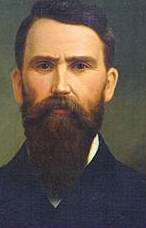James Philip Eagle
| James Philip Eagle | |
|---|---|
 | |
| 16th Governor of Arkansas | |
|
In office January 8, 1889 – January 14, 1893 | |
| Preceded by | Simon Pollard Hughes, Jr. |
| Succeeded by | William Meade Fishback |
| Member of the Arkansas House of Representatives | |
|
In office 1873–1874 1877–1878 1885–1886 | |
| Speaker of the Arkansas House of Representatives | |
|
In office 1885–1887 | |
| Preceded by | W. C. Braley |
| Succeeded by | John Marshall Hewitt |
| Personal details | |
| Born |
August 10, 1837 Maury County, Tennessee |
| Died |
December 19, 1904 (aged 67) Little Rock, Arkansas |
| Resting place |
Mount Holly Cemetery Little Rock, Arkansas 34°44′16.5″N 92°16′38.6″W / 34.737917°N 92.277389°W |
| Political party | Democratic |
| Residence | Lonoke County, Arkansas |
James Philip Eagle (August 10, 1837 – December 19, 1904) was the 16th Governor of Arkansas.
Biography
Eagle was born in Maury County, Tennessee. His family moved to Arkansas early in his life and he was educated in the public schools. He married Mary Kavanaugh Oldham in 1882.[1] Her brother William Kavanaugh Oldham moved to Arkansas in 1885 and later entered politics himself, serving as acting governor for a brief time in 1913. A younger brother, Kies Oldham, served as Eagle's personal secretary during his time as governor.
Career
Eagle was appointed deputy sheriff of Prairie County, Arkansas in 1859, a position he held until the start of the American Civil War. Eagle enlisted in the Confederate States Army and rose to the rank of Colonel. He served with the 5th Arkansas Infantry and the 2nd Arkansas Mounted Rifles. He campaigned with the Army of Tennessee and fought in most of that army's campaigns from the initial battles in Kentucky all the way to the Battle of Nashville. Eagle was wounded during the Atlanta Campaign.
At the conclusion of the war, Eagle attended Mississippi College for less than one year but was forced to withdraw due to illness. He studied for the ministry and was ordained as a Baptist preacher.[2]
Eagle served as a member of the Arkansas House of Representatives from 1873 to 1878. He supported Baxter during the Brooks–Baxter War. Eagle served as speaker of the house in 1875. From 1880 to 1904, he served as president of the Baptist State Convention.
Eagle was elected Governor of Arkansas in 1888, and was reelected for a second term in 1890.[3] The Eagle administration concerned itself with attracting immigration and support for education. Eagle was sympathetic to women's suffrage and once welcomed Susan B. Anthony to the state though he did not provide active political support.
Eagle was elected as president of the Southern Baptist Convention in 1902 and was reelected to that position twice more. He continued to be active in the Baptist church. Eagle served on the state capitol commission but was fired by Governor Jeff Davis for allegedly campaigning for an opponent of Davis. Davis was opposed to the construction of the new capitol building.
Death
Eagle died in Little Rock, Arkansas of heart failure. Eagle is buried at the historic Mount Holly Cemetery in Little Rock.[4]
See also
- Southern Baptist Convention
- Southern Baptist Convention Presidents
- List of Southern Baptist Convention affiliated people
- Brooks–Baxter War
References
- ↑ Who's Who in America, Volume 2, 1901-2, Chicago: A. N Marquis & Co., entry "James Phillip Eagle"
- ↑ "James Phillip Eagle (1889-1893)". Old State Museum. Archived from the original on November 14, 2012. Retrieved August 17, 2012.
- ↑ "Arkansas Governor James Philip Eagle". National Governors Association. Retrieved August 17, 2012.
- ↑ "James Phillip Eagle". Find A Grave. Retrieved August 17, 2012.
External links
- Encyclopedia of Arkansas History & Culture entry: James Philip Eagle
| Political offices | ||
|---|---|---|
| Preceded by Simon Pollard Hughes, Jr. |
Governor of Arkansas 1889–1893 |
Succeeded by William Meade Fishback |
